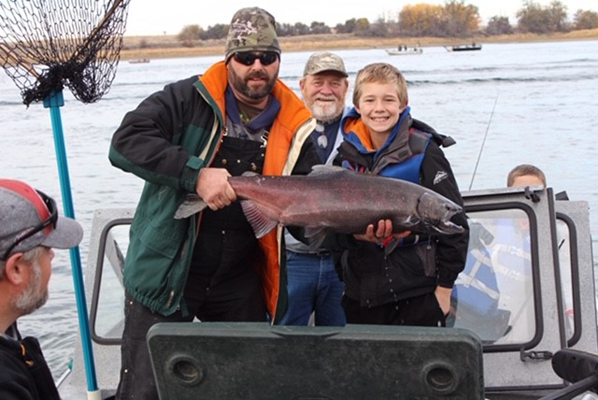King of the Reach fishing derby questions answered
NOTE: Click here for 2024 updates to this blog

The annual King of the Reach (KOR) fishing derby on the Hanford Reach portion of the Columbia River is approaching. The Washington Department of Fish and Wildlife (WDFW) has partnered with the Grant County Public Utility District (GCPUD) and the Coastal Conservation Association (CCA) Tri-Cities Chapter to put on this event every October since 2012.
The goal of the KOR differs from most tournaments. While many fishing derbies focus on individuals catching the most or biggest fish, KOR angler participation helps ensure the future of the Hanford Reach population. The goal of this derby is to collect natural origin Upriver Bright (URB) fall Chinook salmon to incorporate into the broodstock (mature fish used for breeding future generations of fish) of the Priest Rapids Hatchery (PRH). These natural origin broodstock are an important part of the PRH program by providing a pathway to sustain local adaptations and better integrate the natural and hatchery populations occupying the Hanford Reach.

URBs are highly prized by many who fish for them. They are named for the bright sheen that they maintain as they work their way upriver, in contrast to lower river fall chinook that change to duller spawning colors much more quickly. These large salmon come into the Columbia River from the ocean between late July and early October. They are genetically programmed to travel hundreds of miles to their spawning grounds.
The King of the Reach Derby was started to ensure URBs will be around in the future. It was originally implemented as a three-year pilot project but has been so successful that the derby is now a yearly event to help PRH reach its goal of sustaining the abundance of URBs available for harvest. During the tournament, several hundred fish are collected along a thirty-mile stretch of river in the Hanford Reach area over three days during each derby.

While most people recognize the contribution KOR makes to fish conservation, some question the effectiveness of this project and the impact it could have on native fish populations. Here are some questions WDFW is often asked regarding the derby:
Q. What happens to fish caught in this derby? In most salmon derbies, anglers get to keep what they catch.
A. In KOR, the fish caught are handed over to WDFW to be used as broodstock at the Priest Rapids Hatchery to create more fish. No fish are retained for personal consumption by anglers participating in the event.
Priest Rapids produces and releases 7.3 million juvenile fall Chinook salmon into the Columbia River each June on the Hanford Reach. They are not sent to other areas of the Columbia or state for release. These fish contribute significantly to a variety of fisheries from the oceans of Alaska to the Tri-cities.
Q. Why is it important to catch fish from the Hanford Reach and use them for reproduction? Why can’t fish from anywhere be used? And why do they need to be native, not hatchery-origin, fish?
A. Offspring of natural-origin (wild) fish are more genetically adapted to survive in their natural environment. Ideally 30% of hatchery broodstock should come from natural origin fall Chinook, and preferably from URB from the Hanford Reach, to keep native genetics in the gene pool.
The Priest Rapids Hatchery has a fish “trap” that spawning fish enter. Less than 10% of the fall Chinook that end up in the trap are natural origin, and many are from other parts of the Columbia River, making additional efforts to secure natural origin fish a necessity.

Q. Does KOR replace natural populations with hatchery fish? Will natural origin fish eventually be wiped out by this operation?
A. Over the ten years of the KOR program (numbers are broken out by year below), less than 1% (0.6%) of the Hanford Reach natural origin fall chinook population has been collected for KOR. In comparison, an average of 12% of the natural origin fall Chinook are harvested each year by sport anglers on the Hanford Reach. The relatively small number collected during KOR makes a large impact in the genetic makeup of the fish released from the Priest Rapids Hatchery.
The American Fisheries Society recently published a peer reviewed manuscript on this topic.
Having a genetically robust hatchery program with fish that mirror the wild is critical, so if hatchery fish spawn in the wild they will not have a significant effect on the wild population.

Q. Why do people fish this derby if they can’t keep these large fish?
A. While there are many prizes for participants, and it is always fun to fish for big fish, many people recognize the contribution to conservation that KOR makes and support this work. There are many area groups, including high school students, that volunteer to work the derby for the same reason. In the first ten years of KOR, 1,841 volunteers assisted with the Project collecting 6,780 adult fall Chinook. The comradery and friendly competition coupled with the connection to improving fish conservation make this a great event.
Q. What is the mortality rate of Chinook at this event?
A. Each year, only a handful of fish die in the time between being caught and loaded into the hatchery truck.
If you are interested in fishing King of the Reach this year, go to www.ccawashington.org/kingofthereach.
